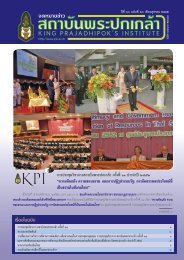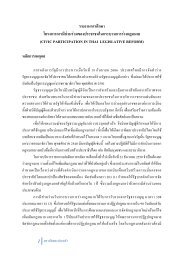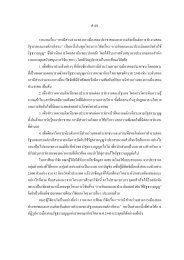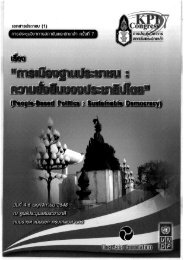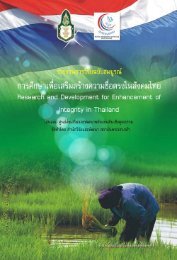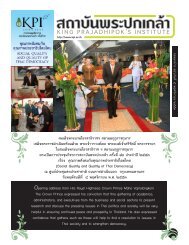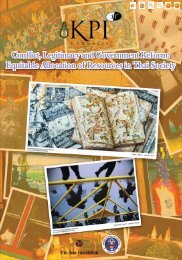SUFFiciENcy EcONOMy ANd GRASSROOtS DEvElOPMENt
SUFFiciENcy EcONOMy ANd GRASSROOtS DEvElOPMENt
SUFFiciENcy EcONOMy ANd GRASSROOtS DEvElOPMENt
You also want an ePaper? Increase the reach of your titles
YUMPU automatically turns print PDFs into web optimized ePapers that Google loves.
196<br />
The Meaning of Sufficiency Economy <br />
International Conference<br />
nation, especially state officials, scholars, and business people at all levels, so they<br />
are conscious of moral integrity and honesty and they strive for the appropriate<br />
wisdom to live life with forbearance, diligence, self-awareness, intelligence, and<br />
attentiveness. In this way we can hope to maintain balance and be ready to cope with<br />
rapid physical, social, environmental, and cultural changes from the outside world.”<br />
NithiEawsriwong, one of the most influential Thai social scientists, concluded<br />
the ultimate goal of Sufficiency Economy was to establish the security of the four<br />
life essences and sustainability (the four life essences included food, clothing,<br />
accommodation, and medicine). This ideology is also the social goal of other<br />
economic philosophies. However, while communism suggested that the security of<br />
four life essences could be established by the state, and capitalism assigned this task<br />
to the mechanism of the free market, the sufficiency economy required the<br />
cooperation among people, community and the state. Unlike the other perspectives<br />
that considered the sufficiency economy as mere agricultural technique or even a set<br />
of financial ethics, Nithi proposed sufficiency economy as a culture. He argued that<br />
the sufficiency economy is the opposite of individualism; it required the<br />
interconnectedness between people and their ecosystem. He asserted that strong<br />
social/community bonds, the social capital, was the key element for achieving the<br />
sufficiency economy (นิธิ เอียวศรีวงศ์ 2543).<br />
The Inpaeng network is another outstanding example of how Isaan people<br />
adjusted themselves in order to cope with the modern constraint. In short, Inpaeng is<br />
the name of a non-profit network that aims to promote a self-reliant lifestyle for<br />
people living around the Phuphan mountain range at the middle of the Isaan area.<br />
One of the Inpaeng’s main strategies was to utilise the unique Thai social capital<br />
acquired from the communities. This research study will explore Thai social capital<br />
according to Inpaeng context.<br />
Method<br />
This study observed social activities and interviewed some key informants<br />
between January and June 2008. Two groups of informants were acquired. The first<br />
group of informants wereInpaeng leaders who involved in Inpaeng network<br />
administration, training course, forest protection, community financial management<br />
and community business. Informants who were Inpaeng members with no<br />
administrative work were categorised into the second group. They were members<br />
who adopted the Inpaeng lifestyle. These informants were the living evidence<br />
confirming that living according to Inpaeng concept could be fruitful. All informants<br />
were informed about the research project before the interview took place and were<br />
asked verbally for the audio recording consent. Most of the observations and<br />
interviews took place in the Inpaengcentre, Kudbak district, Sakonnakhon province,<br />
seven hundred kilometers from Bangkok. The Inpaengcentre is the training venue<br />
and the administrative office of the Inpaeng network. Social events such as Inpaeng<br />
administrative meetings, staff meetings, informal meetings and network conferences<br />
also take place at the Inpaengcentre. However, some social events were observed



